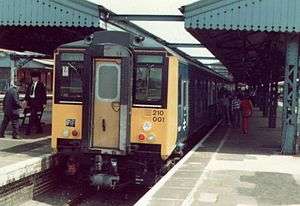British Rail Class 210
The British Rail Class 210 was a type of diesel-electric multiple unit (DEMU) built in 1982 by British Rail Engineering Limited's Derby Litchurch Lane Works. The class was intended to be a modern replacement for the ageing 'first generation' types in use on the Southern Region of British Railways (classes 201 to 207) but the prototypes built did not manage to secure production for the class and were withdrawn in the 1980s.
| British Rail Class 210 | |
|---|---|
 210001 at Reading in 1982 | |
| In service | 1982–1987 |
| Manufacturer | British Rail Engineering Limited |
| Built at | Derby Litchurch Lane Works |
| Family name | BR Second Generation (Mark 3) |
| Number built | 2 |
| Formation | 4 cars (210 001) 3 cars (210 002) |
| Capacity | 254 (210 001) 203 (210 002) |
| Operator(s) | British Rail |
| Specifications | |
| Maximum speed | 90 mph (140 km/h) |
| Prime mover(s) | 1 x MTU 12V396 TC11 (210 002) 1 x Paxman 6RP200L (210 001) |
Design
The class were externally very similar to the first batch of Class 317 EMUs, but half of the forward carriage was taken up by the engine room. Power was provided by an above-floor diesel engine driving a generator to power traction motors on the axles. A single engine was fitted at one end of the train, and the trains operated in a push-pull configuration. As part of the testing, each unit was fitted with a different diesel engine - the 3-car unit received a 1,125 bhp Paxman RP type engine, while the 4-car set had a 1,140 bhp MTU TC type.
A total of seven individual vehicles were built, which were formed into two trains, 210 001 (four-car set) and 210 002 (three-car set). Set 210 001 was an outer-suburban version, with first- and second-class seating, toilets and a luggage van.[1] Set 210 002 was an inner-suburban version provided with high-density second-class seating only.[1] The vehicles were initially given numbers in the DMU series (5xxxx) but quickly renumbered into the DEMU series (6xxxx).
Operation
Sets 210 001 and 210 002 operated in various parts of the country on trial (as did the prototype railbuses, both the single cars and the Class 140 set). Crew training on the Reading-Taunton line commenced in April 1982 with a press demonstration held in May, before entering service on 5 July 1982.[2][3][4]
They operated in the London area of the Western Region: 210 001 was based at Reading TMD and operated between Paddington, Reading, Newbury and Oxford, while 210 002 was based at Southall Depot and operated between Paddington and Slough.[1] In October and November 1983, 210 001 was trialled by ScotRail operating from Edinburgh and Glasgow to Dundee, Fort William and Inverness.[5]
However no more were ordered and their remit was filled by the Class 150 family of Sprinters, which, like the Class 210 (and the Class 317, Class 318 and Class 455 EMUs), were based on the Mark 3 coach bodyshell. The cars led different lives after being withdrawn. The two driving trailers (and the intermediate trailer of the three-car set together with one trailer from the four-car set) were used by Network SouthEast as part of the Class 457 Networker development train. Both the driving cars subsequently passed to the Electric Railway Museum, Warwickshire, one being resold in 2004 to the Eversholt Rail Group. There was a plan for a driving motor to be saved also but, after being stored at Eastleigh Works for many years (still in blue and grey livery), both driving motors were scrapped in May 2003.[6]
One of the TSOs (67400, formerly 60400) is currently in class 455 set 455 912, as a result of the original vehicle being written off with accident damage, and the other two have been scrapped. A DTSO from set 210 002 was inserted into set 455 913, in 2013, after being rebuilt at Wolverton railway works to replace a carriage destroyed in an accident.[7] The vehicle (67301, formerly 60301) was converted to a 455 MSO.[8]
A Class 210 DEMU appears in the music video of the 1984 hit Smalltown Boy by Bronski Beat.
Technical details
| Unit | Introduced | Weight of Power Car | Engine | Transmission | Max Speed |
|---|---|---|---|---|---|
| 210 001 | 1982 | 63.0 t (62.0 long tons; 69.4 short tons) | Paxman 6RP200L of 1,125 bhp (839 kW) | Electric | 90 mph (140 km/h) |
| 210 002 | 1982 | 64.5 t (63.5 long tons; 71.1 short tons) | MTU 12V396 TC 11 of 1,140 bhp (850 kW) | Electric | 90 mph (140 km/h) |
| Key: | In service | Scrapped | Preserved |
|---|
| Unit Number | DMBSO | TSO | TCO(L) | DTSO |
|---|---|---|---|---|
| 210 001 | 60201 | 60401 | 60450 | 60300 |
| 210 002 | 60200 | 60400 | - | 60301 |
See also
- NIR Class 450 - a 3-car DMU class for Northern Ireland Railways built to a similar configuration
References
- Reading Maintenance Depot Open Day (Souvenir Programme). British Rail Western. 1 June 1985. pp. 9, 11.
- "BR tries another railbus tack" Railway Gazette International July 1982 page 561
- "Class 210 on Show" The Railway Magazine issue 976 August 1982 page 344
- "Class 210: The best DEMU yet" Rail Enthusiast September 1982 page 54
- Class 210 Scot-rail
- "Class 210s scrapped" Rail issue 464 25 June 2003 page 67
- "Repairs to 5913 completed" Today's Railways UK issue 138 June 2013 page 66
- New Power Car for 5913 Southern Electric Group
- British Rail Motive Power Recognition 2: DMUs (Ian Allan Publishing), 1983 edition